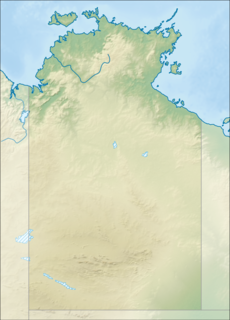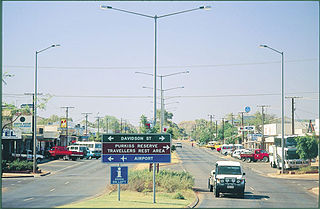

The Tennant Creek Telegraph Station is an historical site about 16 kilometres north of Tennant Creek in the Northern Territory of Australia.


The Tennant Creek Telegraph Station is an historical site about 16 kilometres north of Tennant Creek in the Northern Territory of Australia.
The Warumungu Aboriginal people were the first occupants of the region in and around Tennant Creek. The telegraph station is near a very significant sacred site called "Jurnkurakurr", which is home to a Dreamtime being called "Jalawala", a black-nosed python. [1]
The Tennant Creek Telegraph Station was built in 1872. It was first a temporary bush timber building but by 1875 had been rebuilt with locally quarried stone. [2] It operated as a repeater station as part of the Overland Telegraph Line which connected Darwin to Adelaide. It also operated as a government rations depot. By the 1920s it featured a blacksmith shop, cart shed, ration store, meat house, smokehouse and cellar. Warumungu people were employed at the station as cattlemen and slaughter-men. But the 1890s more than 100 Aboriginal people were living at the station. It was declared an Aboriginal Reserve. [3]
The search for gold began from the 1880s. [4] In 1925, a linesman discovered gold, with the discovery quickly leading to the establishment of a township to the south of the telegraph station. In 1935 a post and wireless office became operational in the town of Tennant Creek itself, [5] so that the telegraph station was closed. It then reverted to a rations depot, supplying meat to the new town and water from its bore until 1966. [6]

| Postmasters/Managers | From | To |
|---|---|---|
| Alan M. Giles [7] | 1875 | 1888 |
| Henry Herbert Dixon | 1915 | 1923 |
| J. W. M. Phillips [3] | 1926 | 1927 |
The station was listed on the now-defunct Register of the National Estate on 25 March 1986. [8] The station was listed on the Northern Territory Heritage Register on 4 July 2001. [1] The land including the Telegraph Station and its immediate surroundings was originally proposed in 1987 as a historical reserve known as the Tennant Creek Telegraph Station Historical Reserve but progress was delayed by a claim on the land made under Aboriginal Land Rights Act (Northern Territory) in 1980 . The claim was resolved in August 2001 with the historical reserve awaiting official naming in April 2002. [9] Significant restoration work was undertaken on the remaining station buildings in 2012. [10]

The Northern Territory is an Australian territory in the central and central northern regions of Australia. Northern Territory shares its borders with Western Australia to the west, South Australia to the south, and Queensland to the east. To the north, the territory looks out to the Timor Sea, the Arafura Sea and the Gulf of Carpentaria, including Western New Guinea and other islands of the Indonesian archipelago.

Karlu Karlu / Devils Marbles Conservation Reserve is a protected area in the Northern Territory of Australia located in the locality of Warumungu about 105 km (65 mi) south of Tennant Creek, and 393 km (244 mi) north of Alice Springs. The nearest settlement is the small town of Wauchope located 9 km (5.6 mi) to the south.

Tennant Creek is a town located in the Northern Territory of Australia. It is the seventh largest town in the Northern Territory, and is located on the Stuart Highway, just south of the intersection with the western terminus of the Barkly Highway. At the 2016 census, Tennant Creek had a population of approximately 3,000, of which more than 50% (1,536) identified themselves as indigenous.

Pine Creek is a small town in the Katherine region of the Northern Territory, Australia. As at the 2016 Census there were 328 residents of Pine Creek, which is the fourth largest town between Darwin and Alice Springs.

Ti-Tree is a town and locality in the Northern Territory of Australia located on the Stuart Highway about 1,109 kilometres (689 mi) south of the territory capital of Darwin and about 193 km north of the municipal seat in Alice Springs.
Mary Alice Ward was an Australian teacher and pastoralist born at Kooringa, Burra, South Australia. She is best remembered for her legendary hospitality as owner and operator of Banka Banka Station, a cattle station and World War II supply camp. In fact, she was known as "The Missuss of Banka Banka."
The Warumungu are a group of Aboriginal Australians of the Northern Territory. Today, Warumungu are mainly concentrated in the region of Tennant Creek and Alice Springs.

Connells Lagoon Conservation Reserve also known as Dalgajini is a protected area in the Northern Territory of Australia.

Illamurta Springs Conservation Reserve is a protected area in the Northern Territory of Australia in the locality of Ghan about 42 kilometres (26 mi) south of Hermannsburg and 140 kilometres (87 mi) west of Alice Springs. The southern foothills of the James Range and the permanent spring from which the reserve takes its name are found within the reserve.

Arltunga is a deserted gold rush town located in the Northern Territory of Australia in the locality of Hart about 110 kilometres (68 mi) east of Alice Springs. It is of major historical significance as the first major European settlement in Central Australia.

The Alice Springs Telegraph Station is located within the Alice Springs Telegraph Station Historical Reserve, four kilometres north of the Alice Springs town centre in the Northern Territory of Australia. Established in 1872 to relay messages between Darwin and Adelaide, it is the original site of the first European settlement in central Australia. It was one of twelve stations along the Overland Telegraph Line.

Mount Riddock Station is a 2,633 square kilometre cattle station in the Northern Territory of Australia. It is managed by Steve and Rebecca Cadzow. They run Poll Herefords on the property, which has organic certification.

The Church of Christ the King is located in Tennant Creek in the Northern Territory of Australia. The church was relocated from the historic mining town of Pine Creek. With parts of the church spread between the two towns during the move, it was once known as the "longest church in Australia".
Tuxworth Fullwood House is a historic building in Tennant Creek in the Northern Territory of Australia. It was known as the No. 55 Australian Camp Hospital during World War II becoming the Tennant Creek Hospital Outpatients Department after the war. It was the first brick building constructed in the town and is one of the last remaining military structures in the Barkly region.

Warumunga is a locality in the Northern Territory of Australia located about 902 kilometres (560 mi) south-east of the territory capital of Darwin.

Ryan Well Historical Reserve, formerly Reserve No. 1343, is a protected area in the Northern Territory of Australia located in the locality of Anmatjere about 129 kilometres (80 mi) north of Alice Springs.

Ali Curung is an Indigenous Australian community in the Barkly Region of the Northern Territory. The community is located 170 km (106 mi) south of Tennant Creek, and 378 km (235 mi) north of Alice Springs. At the 2016 census, the community had a population of 494.

John Flynn's Grave Historical Reserve, more commonly referred to as Flynn's Grave is the grave site of John Flynn who was an Australian Presbyterian minister who founded the Australian Inland Mission (AIM) and founding the Royal Flying Doctor Service. The grave, which is now a historical reserve, is located at the base of Mount Gillen on Larapinta Drive in the Alice Springs suburb of Flynn.

Davenport is a locality in the Northern Territory of Australia located about 1,057 kilometres (657 mi) south of the territory capital of Darwin.

Wauchope is a tiny settlement, on the Stuart Highway, in the Davenport locality in the Northern Territory of Australia, located about 1,057 kilometres (657 mi) south of the territory capital of Darwin.